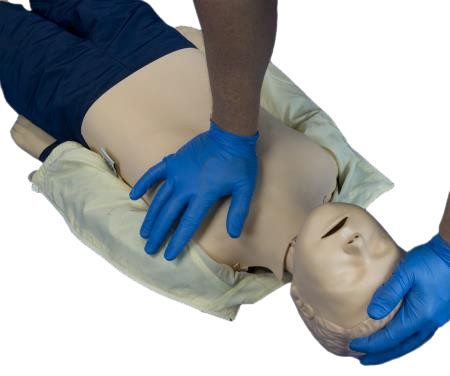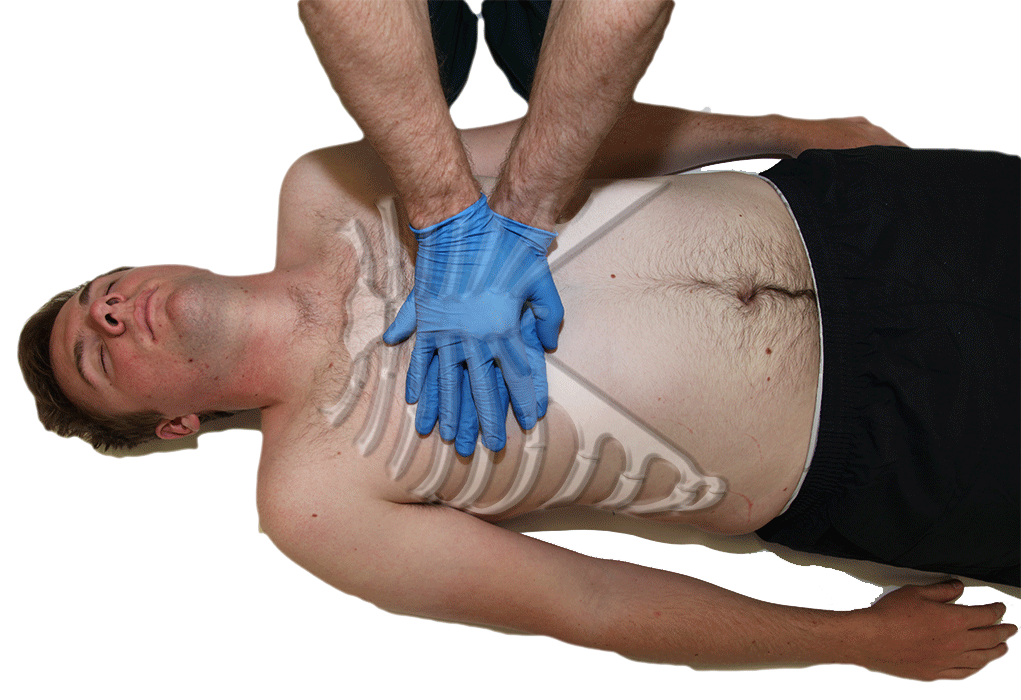
- To provide external chest compressions in a patient with no pulse in order to create blood flow to vital organs and/or sustain a shockable rhythm
- Swap compressors every 2 minutes due to fatigue and degraded compression quality.
- Adopt correct posture (4) at patient’s left.
- Minimise interruptions and limit them to 3 seconds maximum wherever possible.
- Compressions on non-supine patients OR on non-rigid surfaces are usually ineffective.
- Position the patient supine on a firm flat surface. Prepare in line with IMPACT CPR principles:
- Create or move to a good working space with 360° access where possible in a timely manner
- Feedback and CPR quality devices MUST be used where available.
- Begin high quality, focused compressions with minimal interruptions immediately.
| Newborn or infant | The two thumb technique (1) is preferred with 2 rescuers. The hands encircle the chest and the thumbs compress the lower sternum. The two finger technique to minimise the transfer time between compressions and ventilations where only 1 rescuer. |
| Child | Compressions are to be performed with the heel of one hand (2) in the centre of the chest. |
| Adult | Utilise the two handed technique (3) with hands positioned in the centre of the chest. |
- Compression depth is approximately ⅓ the depth of the chest. CPR Feedback devices MUST be used where available.
| Infant | Approximately 4 cm |
| Child < 12 years | Approximately 5 cm |
| Adult | More than 5 cm |
- Allow the chest to fully recoil after each compression.
- Target compression rate is:
| Newborn < 3 hours | 3 : 1 (90 / minute) |
| Infant / Child < 12 years | 15 : 2 (100 - 120 / minute) |
| Adult | 30 : 2 (100 - 120 / minute) |
- The compression to ventilation radio (i.e. 15:2, 30:2) is best defined as 15/30 compressions to 2 seconds pause, to facilitate ventilation. Recommence CPR at 2-3 seconds regardless and do not wait for 2 breaths to be completed.
Focused Compressions
The compressor should never be distracted and must not try to co-ordinate events whilst performing this skill as this leads to degraded performance.- Rate: Compression rates are those advocated by the ARC. Use a metronome where available (Corpuls3 has this enabled). The St. John First Responder App has a metronome in the Toolbox, set at 110 beats per minute.
- Depth: The ARC recommends a depth > 5 cm in adults. In children, the recommended depth is 5cm and in 4cm in infants1. Superficial depth is associated with lower survival probability.
- Recoil: Also referred to as leaning or release, the chest MUST be fully released on the upstroke / decompression phase. Rapid release creates negative pressure that promotes blood return to the thorax, and coronary perfusion. This can prolong shockable rhythms, which improves likelihood of a successful defibrillation.
- Hand Position: The ARC recommend the centre of the chest. Too high is ineffective and too low may precipitate regurgitation.
- Minimal Interruptions: Maximising time on chest with excellent compressions ensures that the blood pressure created is sustained as best as possible. By pausing for as little as 3 seconds, perfusion pressure can be lost completely and it is estimated to take 15 – 20 chest compressions to re-establish adequate perfusion pressure again.
- CorPuls CorPatch CPR Feedback Device

- Philips Q-CPR CPR Meter

- Two-thumb / two-finger compression technique, centre of the chest on a newborn/infant

- Single-handed compression technique on a child, hand positioned in the centre of the chest

- Two-handed compression technique on an adult, hands positioned in the centre of the chest

- Correct position

- Refer to Post-Resuscitation Care (ROSC) Guidelines.
- Refer to Determination of Death Guidelines.
| Settings | |
|---|---|
| Extended Care: | |
| Colour assist: | |
Document Control
Clinical Resources Website
St John Ambulance Western Australia Ltd (ABN 55 028 468 715) (St John WA) operates ambulance and other pre-hospital clinical services. St John WA’s Clinical Resources, including its Clinical Practice Guidelines (Clinical Resources), are intended for use by credentialed St John WA staff and volunteers when providing clinical care to patients for or on behalf of St John WA, within the St John WA Clinical Governance Framework, and only to the extent of the clinician’s authority to practice.
Other users – Terms of Use
The content of the St John WA Clinical Resources is provided for information purposes only and is not intended to serve as health, medical or treatment advice. Any user of this website agrees to be bound by these Terms of Use in their use of the Clinical Resources.
St John WA does not represent or warrant (whether express, implied, statutory, or otherwise) that the content of the Clinical Resources is accurate, reliable, up-to-date, complete or that the information contained is suitable for your needs or for any particular purpose. You are responsible for assessing whether the information is accurate, reliable, up-to-date, authentic, relevant, or complete and where appropriate, seek independent professional advice.
St John WA expressly prohibits use of these Clinical Resources to guide clinical care of patients by organisations external to St John WA, except where these organisations have been directly engaged by St John WA to provide services. Any use of the Clinical Resources, with St John WA approval, must attribute St John WA as the creator of the Clinical Resources and include the copyright notice and (where reasonably practicable) provide a URL/hyperlink to the St John WA Clinical Resources website.
No permission or licence is granted to reproduce, make commercial use of, adapt, modify or create derivative works from these Clinical Resources. For permissions beyond the scope of these Terms of Use, including a commercial licence, please contact medservices@stjohnambulance.com.au
Where links are provided to resources on external websites, St John WA:
- Gives no assurances about the quality, accuracy or relevance of material on any linked site;
- Accepts no legal responsibility regarding the accuracy and reliability of external material; and
- Does not endorse any material, associated organisation, product or service on other sites.
Your use of any external website is governed by the terms of that website, including any authorisation, requirement or licence for use of the material on that website.
To the maximum extent permitted by law, St John WA excludes liability (including liability in negligence) for any direct, special, indirect, incidental, consequential, punitive, exemplary or other loss, cost, damage or expense arising out of, or in connection with, use or reliance on the Clinical Resources (including without limitation any interference with or damage to a user’s computer, device, software or data occurring in connection with such use).
Cookies
Please read this cookie policy carefully before using Clinical Resources from St John WA.
The cookies used on this site are small and completely anonymous pieces of information and are stored on your computer or mobile device. The data that the cookies contain identify your user preferences (such as your preferred text size, scope / skill level preference and Colour Assist mode, among other user settings) so that they can be recalled the next time that you visit a page within Clinical Resources. These cookies are necessary to offer you the best and most efficient possible experience when accessing and navigating through our website and using its features. These cookies do not collect or send analytical information back to St John WA.
Clinical Resources does integrate with Google Analytics and any cookies associated with this service enable us (and third-party services) to collect aggregated data for statistical purposes on how our visitors use this website. These cookies do not contain personal information such as names and email addresses and are used to help us improve your user experience of the website.
If you want to restrict or block the cookies that are set by our website, you can do so through your browser setting. Alternatively, you can visit www.internetcookies.com, which contains comprehensive information on how to do this on a wide variety of browsers and devices. You will find general information about cookies and details on how to delete cookies from your device. If you have any questions about this policy or our use of cookies, please contact us.